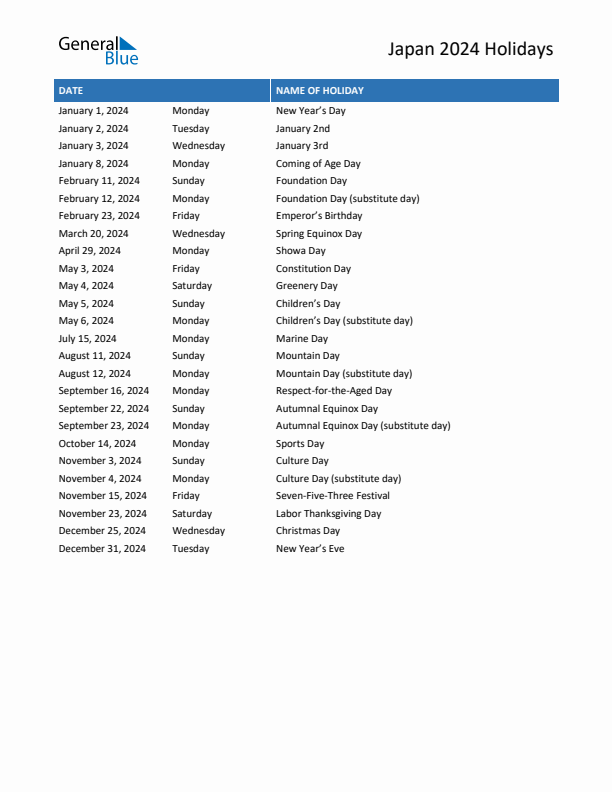Seven-Five-Three Festival in Japan
When is Seven-Five-Three Festival in Japan?
Seven-Five-Three Festival in Japan is on November 15, 2024. It falls on Friday.
How many days until Seven-Five-Three Festival in Japan?
There are 200 Days left until Seven-Five-Three Festival in Japan.
Is Seven-Five-Three Festival a public holiday in Japan?
Seven-Five-Three Festival or commonly known as ‘Shichi-Go-San’ by the Japanese, is a festival celebrated annually every 15th of November in Japan. Japanese young boys who reached the age of five (sometimes three-year old boys are also included, depending on the area) and young girls who reached the age of both three and seven, are the subject of this festival. This day is intended mainly to celebrate these children’s vitality. Since the day is not designated as a public holiday in Japan, it is common for all Japanese to celebrate this festival on the weekend closest to November 15. On the said date, all businesses remain open. Same thing goes with the schools and government institutions in Japan.
Origin of Seven-Five-Three Festival
According to Japanese history, the roots of the Shichi-Go-San Festival can be traced back in the Heian Period (794-1185), when court nobles at that time, celebrated the children’s different stages of growth. During this period, infant mortality rate is actually very high in Japan. This is the reason why the celebration is very important for the ancient Japanese people. Reaching the age of seven was a big deal in the old times considering that many of their young children suffered early deaths due to poor health conditions. Before, the Japanese believed that it was the works of evil spirits which caused the deaths of their youngsters, hence, celebratory ceremonies are held for those children who would reach the age of five (for boys) and age three and seven (for girls). The day was set to celebrate and express gratitude to the deities for granting the children good health and long life. The celebration marked the beginning of the Seven-Five-Three Festival in the country.
There have been many theories associated as to why the numbers three, five, and seven, are the ones used as the celebratory age. The most common is the Japanese belief that odd numbers are lucky numbers. And since the ages three, five, and seven, mark the different stages for the child’s growth amidst the trying health conditions in the past, these specific ages are also selected. These ages are also said to be the specific ages when children of the past times underwent purification ceremonies.
Why is Seven-Five-Three Festival celebrated on 15th of November?
The 15th date of November is chosen since the sum of the numbers three, five, and seven, is fifteen. And although the festival originated during the Heian Era, the said festival was established to be celebrated every 15th of November on its succeeding period, during the Kamakura Period (1185-1333).
Activities and Traditions in Japan during Seven-Five-Three Festival
While Japan has a national holiday called Children’s Day which celebrates the well-being of all Japanese children, another day was set to celebrate a specific age group of Japan’s young population. The day is known as Shichi-Go-San or Seven-Five-Three Festival in English. This festival is held to celebrate those young Japanese boys who reached the age of five and young Japanese girls who reached the age of three and seven. On this day, seeing kids in fancy traditional clothing is expected. And with its observance, it’s customary for the Japanese to have their shrine/temple visits first before doing anything else.
Shrine Visits in Finest Traditional Clothing
Shrine visits are what makes up the Seven-Five-Three Festival in the modern celebration. Prayers are offered to wish for the children’s happiness, healthy growth, and future successes. During these visits, the children involve would usually dress up extravagantly. They would wear the finest traditional clothes for the celebration. Since these traditional clothes are a bit expensive, many Japanese who have five-year old boys and three and seven-year old girls, would rent out these clothing from rental shops, rather than buying one. Some of these shops would even offer additional services like hair and make-up for the little girls. The young girls face would be adorned with make-up and their hair are expected to be beautifully done during the event. Crowds of families would be seen everywhere in the country during the event.
Basically, the festival is a family-focused kind of event, so it looks more of like a family day in Japan. So, once the shrine visits are over, other families would organize special banquets for their friends, relatives, and families. However, most of them would often arrange for a photoshoot of their kids. Several family pictures are also taken in various photo studios across the country. The festival would not be completed without photography. Since it’s a special occasion for the children, parents, grandparents, aunts, uncles, other relatives, and friends, would join the celebration. As a memento of the event, taking pictures and videos are typical on this day.
Kamioki Ceremony
The Japanese are well-known for taking their holidays and festivals seriously, and Seven-Five-Three Festival is not an exception. In fact, this festival is one of the most popular festivals occurring during the autumn season in Japan. As part of the Japanese traditions, ceremonies are held during this festival. ‘Kamioki’ is the first of these ceremonies. Kamioki literally means ‘leaving the hair. In the ancient times, one of the customary practices in Japan, is shaving the heads of their babies 7 days after its birth. The little kids (both boys and girls) are not allowed to grow their hair until they reach the age of three. Once they reach this specific age, they would be a part of the kamioki ceremony. This event marks the beginning for these little kids to have their hair finally grow out. However, at present, since traditions evolved, this specific practice of shaving the infants’ heads have long been discarded. Currently, during the festival, young children of age three (girls and sometimes boys are included, depending on the area) are seen wearing the traditional Japanese kimono. These kimonos are worn without obi, but with shoulder tucks, and a padded vest known as ‘hifu’ in the Japanese language.
Hakama-gi-no-gi
The second ceremony held is called ‘Hakama-gi-no-gi’. This ceremony is intended for five-year old boys alone. This is the event wherein these boys are finally allowed, for the very first time, to wear the traditional formal clothing for the male Japanese. These traditional clothing worn is called ‘Hakama’ (a traditional piece of samurai clothing which looks like a loose pleated trousers) and ‘Haori’ (a Japanese formal coat worn over a kimono).
Obitoki-no-gi
‘Obitoki-no-gi’, is the third ceremony held during the festival. This event on the other hand, is intended for the seven-year old girls. This is the time when girls aged seven are given the right to wear the ‘obi’ (a belt/sash used to tie the kimono and is somehow more expensive than the kimono itself when purchased brand-new). The obis are only being worn by adult Japanese women, thus, this ceremony done marks the transition of the seven-year old girls from being little kids down to the path of womanhood.
Chitose Ame, the most popular gift on Seven-Five-Three Festival
With the celebration of the Seven-Five-Three Festival, a special treat is also given towards the children. Aside from small gifts from the children’s family, a specific treat is also given to the kids on this day. ‘Chitose Ame’ is what it’s called. Chitose Ame (a thin-looking, red and white candy) means a thousand-year candy. Since this symbolizes growth and longevity in Japanese culture, this is the most popular treat given to the children during the festival. These candies are to be given inside a bag which is also full of decorations. Such decorations are said to symbolize long life and good luck in the country as well. The designs/decorations likely seen in these bags include: tsuru (cranes), kame (turtles), matsu (pine), ume (plum), and take (bamboo).
| Year | Date | Day | Holiday |
|---|---|---|---|
| 2024 | November 15 | Friday | Seven-Five-Three Festival |
| 2025 | November 15 | Saturday | Seven-Five-Three Festival |
| 2026 | November 15 | Sunday | Seven-Five-Three Festival |
| 2027 | November 15 | Monday | Seven-Five-Three Festival |
| 2028 | November 15 | Wednesday | Seven-Five-Three Festival |
| 2029 | November 15 | Thursday | Seven-Five-Three Festival |
| Holiday | Date |
|---|---|
| Showa Day | April 29, 2024 |
| Constitution Day | May 03, 2024 |
| Greenery Day | May 04, 2024 |
Download or print free 2024 calendar which includes the list of holidays in United States. Free holiday calendar templates in more than 130 countries are provided in PDF, Excel, and Microsoft Word format. For those who like to get a calendar that starts on Monday, we also have ISO calendar.
The April 2024 monthly calendar for the United States shows the holidays for the month, which is helpful in planning schedule and events in reference to the upcoming holidays in the US. It is available in PDF, Microsoft Word and Microsoft Excel formats. You may select your preferred orientation and preferred start of week since we have Monday start calendar or Sunday start calendar.
If you are looking for just a list of holidays in the United States for the year 2024, we have that available in PDF, Word and Excel formats. This can be helpful for those who like to keep track of the holidays, be it for travel, work or any other purposes. It is free to use, just like the rest of our templates. You can choose from Letter, Legal and A4 paper sizes.


